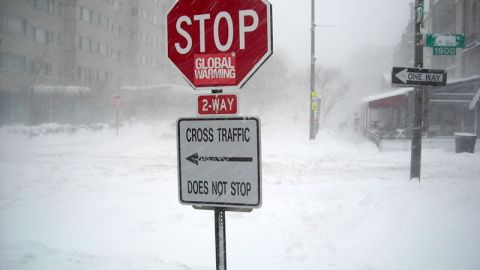Cold Snap

The huge snowstorms that hit the mid-Atlantic states may have done more than just close roads and schools. They may also have had a chilling effect on climate change legislation in Congress. On the face of it, a record-breaking snowstorm seems to give the lie to the idea that earth could be getting hotter. Sen. Jim DeMint suggested that the storm was evidence that global warming skeptics were right, and the Virginia Republican Party ran an ad mocking the storm as “12 inches of global warming.” And Sen. Jeff Bingaman (D-NM), the chair of the Senate Energy and Natural Resources Committee, told The Hill that the blizzards that had shut down Congress would make it harder to get votes for a climate change bill, saying that the storm made it “more challenging for folks not taking time to review the scientific arguments.”
The storm, of course, doesn’t undermine the scientific case for global in the slightest. Although a dramatic cold-weather event might seem to be at odds with the idea that the planet is steadily warming, climate scientists have never argued that that global warming would mean the end of large and even record-setting blizzards, at least in the near term. On the contrary, shifting weather patterns should actually mean larger storms and more precipitation. If the storm is evidence of anything, in other words, it’s that weather patterns are changing dramatically.
No one storm actually says much about long term weather patterns, any more than large waves say much about the overall sea level. The weather naturally fluctuates in ways that are locally difficult to predict. Global warming means only that on average the worlds temperatures are rising, not that temperatures are increasing linearly in any given region. Changing ocean currents could even mean that some areas actually get colder as the average global temperature rises. More to the point, as Bradford Plumer explains, getting a lot of snow doesn’t mean having a cold winter. In fact, we tend to get the largest snowstorms in warmer-than-average years. That’s because as the average temperature rises, more water evaporates into the air, leading to greater precipitation. In the winter, that means larger snowstorms.
The underlying evidence for global warming has meanwhile not changed. The overwhelming scientific consensus is that the earth is rapidly warming because of human activity. The recent snowstorm notwithstanding, we just had another one of the warmest Januaries on record. Not only have average winter temperatures increased several degrees since the 1970s, but spring now arrives as much as two weeks earlier than it did just 20 years ago. And for all the recent talk of a brief dip in global temperatures, the fact is, as the National Oceanic Atmospheric Administration’s Deke Arndt says, that “The last 10 years are the warmest 10-year period of the modern record. Even if you analyze the trend during that 10 years, the trend is actually positive, which means warming.”
None of that’s necessarily obvious to someone who has to shovel their driveway out every day. But politicians and journalists should know better. With so much at stake, they have a responsibility to to make sure they know what they’re talking about, so we can make informed decisions about what we need to do.





